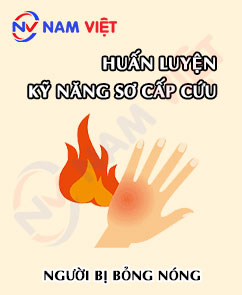First aid training for individuals who are drowning
500,000 ₫
Note: The above price is calculated per person. Prices may vary depending on the number of participants in the course and market fluctuations. For more accurate pricing, please refer to the price list or contact our consulting staff directly.
Table of Contents
Toggle1. Identifying a Drowning Victim
a. Cases of drowning
Drowning is a common accident that can be life-threatening. Below are some cases of drowning and emergency response procedures:
- Drowning victim still in water: In this case, rescuers should quickly remove the victim from the water, using a rescue tool if available to safely pull them out. Check breathing and perform rescue breathing if necessary, then call emergency services or take the victim to the nearest hospital.
- Drowning victim already out of water: If the victim has been removed from the water, the rescuer should quickly take them to a safe location and provide rescue breathing if necessary. If the victim is not breathing, perform rescue breathing immediately and call emergency services or transport them to the nearest hospital.
- Victim in critical condition: If the victim is in critical condition and not breathing, the rescuer should perform mouth-to-nose or mouth-to-mouth breathing immediately, then take the victim to the nearest hospital for urgent care.

b. Signs someone is about to drown
A drowning victim often shows warning signs. Some signs include:
- Difficulty breathing or gasping: Victims will struggle to reach the surface for air. When unable to breathe, they show labored breathing or gasping.
- Calling for help: Victims often call for assistance when in danger in the water.
- Improper swimming technique: Struggling or uncoordinated swimming may indicate imminent drowning.
- Chest pain or heart attack: These symptoms may signal that a person is about to drown.
- Difficulty moving in water: Trouble swimming or maintaining position in water can indicate drowning.
- Panic: Victims often experience panic and are unable to help themselves.
Recognizing these signs helps rescuers take timely action. However, not all signs may be present, so practicing water safety is crucial to prevent drowning.

c. Assessing the condition of a drowning victim
Assessing a drowning victim is essential for effective rescue and medical care. Common conditions include:
- Conscious: The victim may attempt to surface for air. Provide a flotation device and guide them to safety.
- Unconscious: Check if the victim is breathing. If not, perform CPR immediately to save their life.
- Labored or gasping breathing: Take the victim to safety and call emergency services for hospital transport.
- Pulmonary edema: A serious condition that may develop after drowning. If the victim has difficulty breathing after rescue, transport them to a hospital for treatment.
- Heart failure: If the victim shows fatigue or difficulty breathing after rescue, they should be taken to a hospital for urgent care.

d. Golden time for drowning cases
The golden time for drowning cases is approximately 4-6 minutes. During this period, victims need immediate rescue and medical attention to maximize survival and minimize severe health damage.
Within the first 4-6 minutes after drowning, the body starts to lack oxygen, causing cellular damage and death. As time passes, the damage spreads and can lead to heart failure, pulmonary edema, or death.
Therefore, upon spotting a drowning victim, rescuers must act quickly: shout for help, bring the victim to safety, perform CPR if unconscious, and call emergency services for on-site assistance and hospital transport.
In summary, the golden time is critical for rescuing and treating drowning victims. Quick and accurate actions during this window are vital to save lives.

2. Overview of first aid training for drowning cases
a. What is a first aid training course?
A first aid training course is designed to teach learners both basic and advanced first aid skills. It includes lessons and practical exercises on handling emergencies such as cardiac arrest, respiratory failure, poisoning, injuries, and other urgent situations.
The course equips learners with skills to respond effectively to emergencies, minimize harm to themselves and others, increase survival chances, and ensure timely transfer to medical facilities.
REGISTER FOR BASIC FIRST AID TRAINING
b. Training duration
Initial first aid training:
- For employees: 4 hours.
- For first aid and emergency responders: 16 hours (2 days).
Periodic first aid training:
- For employees: 2 hours.
- For first aid and emergency responders: 8 hours (1 day).
c. Course content
- Basic principles of first aid and on-site emergency care
- Wound bandaging (principles, tools, techniques)
- Temporary bleeding control techniques (principles and methods)
- Temporary fracture stabilization techniques (principles and tools)
- Cardiopulmonary resuscitation (recognizing signs of cardiac arrest, airway clearance, breathing support, CPR guidance)
- Burn management (assessing cause and severity, on-site first aid)
- Safe victim transportation with and without stretchers for initial care
- Specific emergency care scenarios:
- Electric shock
- Drowning
- Chemical accidents
- General guidance on first aid kit use
- Practical exercises for all content areas
d. First aid training certificate
Upon completing the course, learners receive a certificate confirming completion of the first aid training program under the Group 2 training framework as specified in Appendix IV, Decree 44/2016/ND-CP. The certificate is valid for 1 year.


3. Essential Tools for a First Aid Kit in Case of Drowning
For a first aid kit to handle drowning cases, the following basic tools are necessary:
- Rescue breathing bag: A rescue breathing bag provides oxygen to victims who cannot breathe or have inhaled water. The bag should have a one-way valve and a mask to prevent contamination.
- Rescue breathing bag with oxygen tube: This bag provides oxygen to victims experiencing asphyxiation or breathing difficulties due to drowning. Ensure the bag has enough oxygen and the tube is securely connected.
- Face shield: Protects the rescuer from contaminants and fluids in the victim’s mouth while performing CPR.
- Clothing scissors: Allows quick and easy removal of the victim’s clothing to access and treat drowning conditions.
- Rubber gloves: Protects the rescuer’s hands from external contaminants such as dirt, blood, water, and fluids during rescue and first aid.
- Airway clamp: A device that helps keep the victim’s airway open, facilitates oxygen delivery, and reduces cardiac stress.
- Gauze and adhesive tape: Prevents infection and cleans wounds after successful first aid.
Additional tools such as manual air pumps, rescue tubes, water collection trays, etc., are recommended for preparedness in drowning situations.

REGISTER FOR BASIC FIRST AID TRAINING
4. First Aid Procedure for Drowning Victims
The first aid procedure for drowning victims includes the following steps:
- Assess the victim’s condition: Approach the victim safely and check if they are breathing and have a pulse. If not breathing or without a pulse, start CPR immediately.
- Request others to call for help: Ask someone else to call emergency services. A watch or mobile phone can be used to monitor time and call for help.
- Bring the victim to shore: If the victim is in the water, bring them to shore immediately. Use a boat, ladder, or any available tool. For deep-water cases, assistance from swimmers or lifeguards may be needed.
- Perform CPR: If the victim is not breathing or has no pulse, perform CPR immediately. Place your hands in the center of the chest and compress up to 5 cm. Perform chest compressions at a rate of 100-120 per minute with rescue breaths at a ratio of 30:2 (30 compressions followed by 2 rescue breaths).
- Keep the victim warm: Use blankets or towels to maintain body heat. After successful first aid, transport the victim to a hospital to check for injuries or cardiac issues.
5. Benefits of First Aid Training
First aid training provides many important benefits for individuals and communities:
- Saving lives in critical situations: First aid skills enable trainees to save someone whose life is at risk, such as cardiac arrest, respiratory arrest, poisoning, injuries, and other emergencies.
- Helping others learn first aid: Trained individuals can share knowledge and experience with others, enabling the community to protect itself and reduce mortality in emergency situations.
- Reducing rescue waiting time: When trained first aiders handle emergencies on-site, waiting time for rescue teams is minimized.
- Enhancing response and reducing stress in emergencies: First aid training helps learners respond accurately and quickly, reducing stress and anxiety while waiting for help.
- Increasing survival rates and reducing fatalities: Timely and proper first aid increases survival chances and reduces complications or deaths in emergency situations.

6. First Aid Training Capacity of An Toan Nam Viet
An Toan Nam Viet is a reputable and high-quality first aid training center in Vietnam. Continuous training sessions are conducted at manufacturing workshops, factories, and construction sites nationwide (all 63 provinces of Vietnam).
REGISTER FOR BASIC FIRST AID TRAINING
Training Certification
- An Toan Nam Viet has been inspected and certified by the Department of Safety under the Ministry of Labor – Invalids and Social Affairs, granting certification for occupational safety and hygiene training. Within the Group 2 training program, the first aid skills module is included, further reinforcing our capacity in first aid training.

Training Materials and Lectures
- Before first aid training materials are used in first aid courses, they are reviewed to ensure accuracy and practical effectiveness.
- Instructors’ teaching methods are standardized according to An Toan Nam Viet standards, developed by experts in first aid training to maximize knowledge retention for trainees.
Facilities
- Controlling factors in the training room enhances teaching efficiency and knowledge absorption.
- Our training facilities provide spacious classrooms meeting standards for space, lighting, and training equipment, etc.
7. Nationwide First Aid Training Centers
An Toan Nam Viet is one of the most reputable and professional organizations for first aid training in Vietnam. With experienced instructors, modern equipment, and high-quality programs, the center has become an ideal destination for those interested in protecting lives and health.
By participating in courses at An Toan Nam Viet, you will learn basic and advanced first aid skills, including CPR for cardiac arrest, respiratory arrest, poisoning, injuries, and other emergency situations. The program is flexible and suitable for all learners, from adults to children, medical staff, rescue personnel, and the general public.
An Toan Nam Viet’s first aid training not only teaches essential life-saving skills but also fosters awareness to protect your own life and health as well as those around you. Training by experienced and highly qualified instructors ensures confidence and readiness for any emergency situation.
Register for first aid courses at An Toan Nam Viet to protect your life, health, and the community.
1 review for First aid training for individuals who are drowning
No comments yet











phanminhhang341
Very good and professional first aid training unit